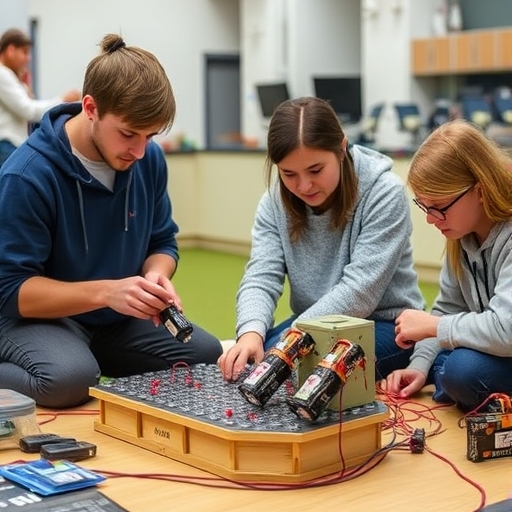How College Students Built Satellite Batteries
In the realm of aerospace engineering and technology, one of the most exciting developments in recent years has been the participation of college students in the creation of satellite batteries. These students have shown remarkable innovation, collaboration, and technical prowess, turning theoretical knowledge into practical applications that support space exploration and satellite functionality. This article explores how college students are building satellite batteries, the challenges they face, and the implications of their work for the future.
The Importance of Satellite Batteries
Satellite batteries are crucial components of any satellite system. They provide the necessary power to keep the satellite operational when it is not in direct sunlight. Here are some key points about their importance:
- Power Supply: Satellite batteries ensure that all onboard systems, including communication systems, sensors, and scientific instruments, receive the power they need to function.
- Operational Longevity: A well-designed battery can extend the operational life of a satellite, allowing it to continue its mission for years beyond its expected lifespan.
- Cost Efficiency: Developing efficient batteries can reduce the need for frequent satellite replacements, saving costs for space agencies and private companies alike.
- Access to Resources: Many universities have partnerships with aerospace companies and government agencies, providing students with access to advanced resources and mentorship.
- Innovative Mindset: College students often approach problems with fresh perspectives that can lead to innovative solutions.
- Hands-On Experience: Working on real-world projects gives students invaluable practical experience that enhances their education.
- Energy Density: Increasing energy density to maximize power storage while minimizing weight.
- Rapid Prototyping: Utilizing 3D printing and other rapid prototyping techniques to create battery components quickly.
- Testing and Validation: Conducting rigorous testing to ensure reliability in the harsh conditions of space.
- Modular Design: A modular approach that allows for easy upgrades and replacements.
- Performance Metrics: Focusing on performance metrics such as charge/discharge cycles and thermal management.
- Solar Integration: Integrating solar panels directly into the battery design to enhance efficiency.
- Sustainability: Developing batteries using sustainable materials to minimize environmental impact.
- Material Limitations: Finding lightweight, durable materials that can withstand extreme temperatures and radiation in space.
- Power Management: Designing efficient power management systems that can handle energy fluctuations.
- Funding: Securing funds for research and development can be a significant hurdle.
- Resource Allocation: Balancing project work with academic responsibilities can be challenging.
- Teamwork: Working effectively in teams with diverse skill sets requires strong communication and collaboration.
- Mentorship: Finding adequate mentorship to guide students through complex engineering problems can be difficult.
- Solid-State Batteries: Research into solid-state batteries promises higher energy densities and improved safety compared to traditional lithium-ion batteries.
- Nanotechnology: The use of nanomaterials in batteries could lead to lighter and more efficient power storage solutions.
- Hybrid Systems: The integration of renewable energy sources, such as solar and wind, into satellite battery systems is likely to become more prevalent.
- Energy Harvesting: Techniques for harvesting energy from the environment, such as thermoelectric generators, may be utilized in future designs.
- Industry Partnerships: More collaborations between universities and industry players will help students gain access to resources and expertise.
- Interdisciplinary Teams: The future of satellite battery development will likely involve interdisciplinary teams, combining knowledge from engineering, materials science, and environmental studies.
The Role of College Students in Battery Development
Why College Students?
The involvement of college students in satellite battery development is driven by several factors:
Case Studies of Student-Led Projects
Several universities have spearheaded student-led projects focused on satellite battery development. Here are a few notable examples:
1. MIT’s Space Systems Laboratory
At MIT, students at the Space Systems Laboratory have developed a battery system designed for small satellites (CubeSats). Their work emphasizes:
2. Georgia Tech’s CubeSat Program
Georgia Tech’s CubeSat program has seen students design a satellite battery that uses lithium polymer technology. Key features of their project include:
3. University of California, Berkeley
Students at UC Berkeley have been working on hybrid battery systems that combine solar energy with traditional battery technology. Their innovative approach involves:
Challenges Faced by Student Engineers
While the journey to developing satellite batteries is exciting, it is not without its challenges. Some of the most common obstacles faced by college students include:
Technical Challenges
Financial Constraints
Collaboration and Team Dynamics
The Future of Satellite Battery Technology
As technology continues to advance, the future of satellite battery development looks promising. Here are some emerging trends and predictions:
Advanced Materials
Renewable Energy Integration
Increased Collaboration
Comparison Table of Battery Technologies
| Battery Type | Energy Density (Wh/kg) | Cycle Life (Cycles) | Weight (kg) | Application Area |
|---|---|---|---|---|
| Lithium-Ion | 150-250 | 500-1500 | Varies | General satellite applications |
| Lithium Polymer | 200-300 | 300-1000 | Varies | CubeSats and small satellites |
| Solid-State | 300-500 | 1000-3000 | Varies | Next-gen satellite applications |
| NiMH (Nickel-Metal Hydride) | 60-120 | 300-500 | Heavier | Older satellite technology |
Conclusion
The involvement of college students in satellite battery development is a testament to the innovation and creativity present in academic institutions. As these students tackle complex engineering challenges, they are not only gaining valuable experience but also contributing to the future of space exploration. With advancements in technology and materials, the next generation of satellite batteries will be more efficient, sustainable, and capable of supporting increasingly ambitious missions.
FAQ
What are satellite batteries used for?
Satellite batteries provide power to satellites when they are in the Earth’s shadow and cannot receive solar energy. They ensure that all onboard systems remain operational.
How do college students contribute to satellite battery development?
College students contribute by engaging in hands-on projects, collaborating with industry partners, and applying their theoretical knowledge to practical challenges in aerospace engineering.
What challenges do students face in this field?
Students face technical challenges related to material limitations and power management, financial constraints for funding their projects, and team dynamics in collaborative work.
What is the future of satellite battery technology?
The future includes advancements in solid-state batteries, increased integration of renewable energy sources, and more interdisciplinary collaboration between engineering and other fields.
How can students get involved in satellite battery projects?
Students can join university programs focused on aerospace engineering, participate in competitions, or seek internships with companies involved in satellite technology.
By fostering a culture of innovation and collaboration, college students are paving the way for the next generation of satellite technology, ensuring that we continue to push the boundaries of what is possible in space exploration.





